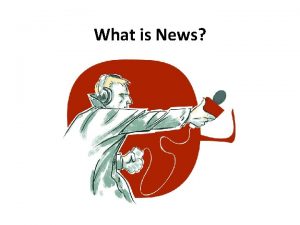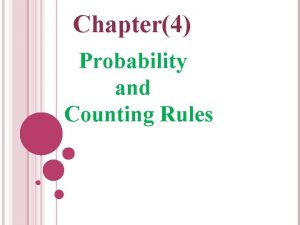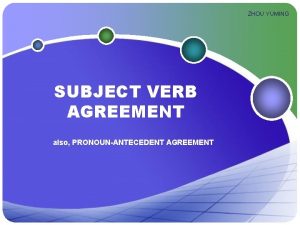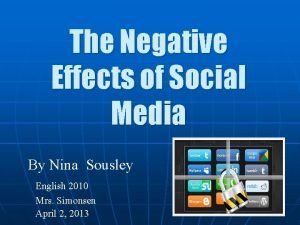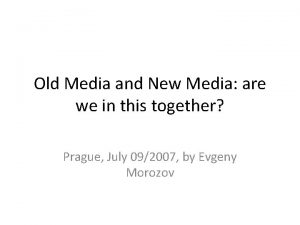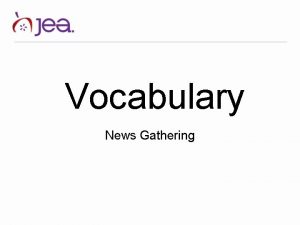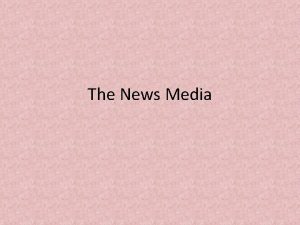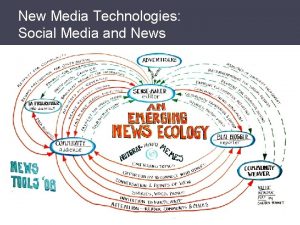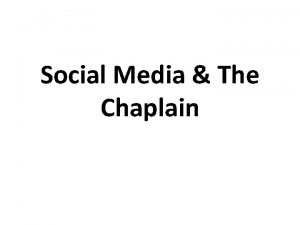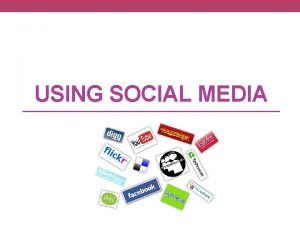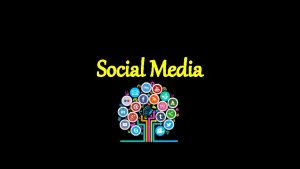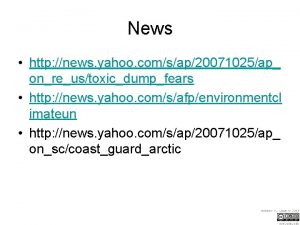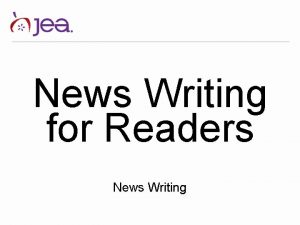SOCIAL MEDIA The NEW news society SOCIAL MEDIA














- Slides: 14

SOCIAL MEDIA The NEW news society. . .

SOCIAL MEDIA HAS CHANGED JOURNALISM Readers once found stories and journalists by picking up a newspaper or magazine, clicking on their TV or turning on a radio NOW AUDIENCES FIND NEWS THROUGH SOCIAL MEDIA SITES Now journalists and media companies who want to engage with an audience need to be where those readers are looking for news: SOCIAL MEDIA SITES

HOW HAS IT CHANGED? Ø News and information is being shared in real time across the internet Ø 70% of Millenials followed daily news but receive it passively as part of their social media feed Ø Social media sites, such as Facebook and Twitter have come to dominate the news conversation BECAUSE news can be shared and discussed in real time Ø Reporters can connect with sources and audiences Ø Helps journalists develop a personal brand or identity in tandem with AND apart from the rest of their newsroom

HOW DO JOURNALISTS USE SOCIAL MEDIA? v To find stories v To monitor developments in breaking news stories as they happen v As a reporting tool to find eyewitnesses, sources and images v To engage readers or viewers through continuous news updates v To promote content both pre- and post-publication v To develop an on-going relationship with the audience

SOCIAL MEDIA IS NOT A REPLACEMENT FOR TRADITIONAL REPORTING It can be used to provide you with notice of real time events and access to potential sources, but, just like with traditional reporting YOU MUST VERIFY WHAT YOU ARE BEING TOLD!

SOCIAL MEDIA PLATFORMS Determine your social media platform by what your audience is using Ø FACEBOOK largest user base, very complicated algorithm determines what readers see Ø TWITTER the news source for the social media world, YOU should develop a strong Twitter presence (a JOURNALISTIC Twitter presence) Ø SNAPCHAT just temporary posts, but VERY popular among young audiences Ø INSTAGRAM image driven posts, considered a “service” for your audience

FACEBOOK THE GOOD THE BAD q Obvious choice for sharing stories u Lack of guaranteed distribution of your posts q Huge audience base q Allows for both breaking and longer form story presentation q Users can like, share or comment on your post q Photo and video embedding allow seamless integration and fast downloads u Because of the algorithm used in its news feed, not every Facebook follower you have will be notified of your posts u Facebook only reaches people who already follow you; this limits your reach to existing followers and their followers if they choose to share you

TWITTER THE GOOD THE BAD q The go-to for breaking news u Speed and ease can be a disadvantage q Eyewitness accounts of news events in real u 140 character post limit does not allow for time complex ideas q Reporters can use hashtags, keywords and u Hard to stand out because of huge amount locations to find and follow breaking news of usage q Comparing tweets and locations, reporters u Misinformation during breaking news can find sources and verify accounts q Good for promoting coverage

USING TWITTER JOURNALISTICALLY YES… IT’S DIFFERENT FROM YOUR PERSONAL TWEETS v Write like you are talking to a friend BUT not sloppy v Talk like you are having a conversation - talk WITH but not AT v Use @ mentions to cite your sources v Include hashtags to make them easily searchable NO MORE THAN TWO HASHTAGS PER TWEET v Add photos - Tweets with pix and vid get twice as many retweets v Use Bit. ly to shorten links or the URL could eat up your character space

WHEN TO USE TWITTER JOURNALISTICALLY v Tweet before, during and after the event v Use Twitter in newsgathering to crowdsource ideas and people v Use Twitter to promote an upcoming event v Tweet during the event - follow it from start to finish USE THE FUNDAMENTALS OF JOURNALISM – BE FAIR and ACCURATE

MANAGING YOUR PROFESSIONAL SOCIAL MEDIA SO… you’ve got a personal account, a journalist account and an account you manage for the publication or website you are producing - HOW DO YOU KEEP TRACK OF ALL OF IT? Social media management tools Hootsuite Tweetdeck Storify

HANDLING YOUR PRO JOURNALIST ACCOUNT Ø Don’t hide the fact that you’re a journalist - transparency Ø Don’t say anything you wouldn’t want to see on the front page of a newspaper Ø Don’t say embarrassing things or hurtful things Ø Don’t argue with an audience member Ø Don’t tweet when you are angry Ø Don’t steal information or post without sourcing Ø Don’t just STOP in the middle of coverage - keep talking Ø BE PATIENT and ENGAGING - give your audience chances to respond

ACTIVITY Creating and managing our social media #Goals ● Create a journalist Facebook page for yourself ● Create a journalist Twitter account for yourself ● Create a journalist Instagram for yourself ● Experiment with Hootsuite and Tweet. Deck to decide which one works for you ● Get to know Storify and decide if this is something we want for our class media

SOCIAL MEDIA The NEW news society. . .
 What is hard news
What is hard news Chapter 4 probability and counting rules answer key
Chapter 4 probability and counting rules answer key Both of the statues on the shelf is broken
Both of the statues on the shelf is broken Social media negative effects
Social media negative effects Gertler econ
Gertler econ New media vs old media
New media vs old media Hát kết hợp bộ gõ cơ thể
Hát kết hợp bộ gõ cơ thể Ng-html
Ng-html Bổ thể
Bổ thể Tỉ lệ cơ thể trẻ em
Tỉ lệ cơ thể trẻ em Gấu đi như thế nào
Gấu đi như thế nào Thang điểm glasgow
Thang điểm glasgow Bài hát chúa yêu trần thế alleluia
Bài hát chúa yêu trần thế alleluia Các môn thể thao bắt đầu bằng tiếng chạy
Các môn thể thao bắt đầu bằng tiếng chạy Thế nào là hệ số cao nhất
Thế nào là hệ số cao nhất
